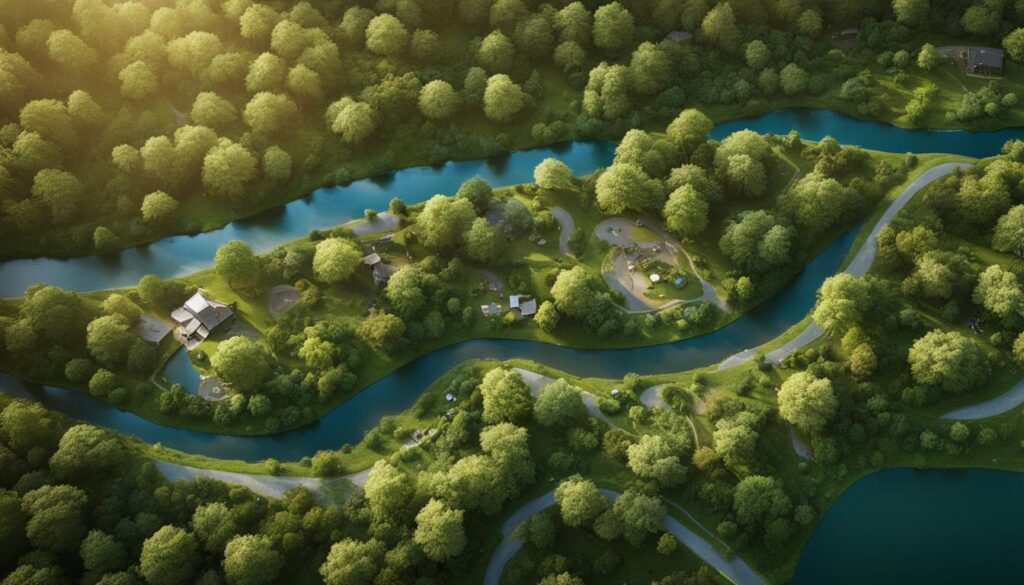Welcome to the world of dispersed camping, where outdoor enthusiasts can break free from the confines of traditional campgrounds and embrace a more adventurous and immersive camping experience. But what exactly does dispersed camping mean? Let’s dive into the definition and explore the wonders of this growing trend.
Key Takeaways:
- Dispersed camping is the practice of camping on public land without the amenities typically found in traditional campgrounds.
- It offers solitude, quiet, and a closer connection to nature, but also requires the responsibility of practicing Leave No Trace principles and being mindful of the environment and other campers.
- Dispersed camping provides flexibility, seclusion, and budget-friendly options, but campers must be self-sufficient and prepared.
- Research and planning are necessary to find dispersed camping areas, which can be done through contacting local ranger districts, using websites and apps, and accessing topographical maps.
- Responsible camping practices, such as following Leave No Trace principles and respecting regulations, are essential to minimize environmental impact.
The Benefits of Dispersed Camping
Dispersed camping offers outdoor enthusiasts numerous benefits. It allows for greater flexibility and the ability to find camping spots at the last minute, without the need for reservations. This makes it an ideal choice for spontaneous adventurers who want to embrace the beauty of nature on their terms.
One of the key advantages of dispersed camping is the opportunity to camp in more remote and secluded areas. Unlike crowded campgrounds, dispersed camping allows you to immerse yourself in the tranquil wilderness, away from the hustle and bustle of civilization. The serene surroundings create a peaceful atmosphere that encourages relaxation and rejuvenation.
Another enticing aspect of dispersed camping is its affordability. Unlike traditional campgrounds, which often charge camping fees, dispersed camping is typically free of charge. This makes it a budget-friendly option for those seeking an immersive outdoor experience without breaking the bank.
However, it is crucial to note that dispersed camping does not provide amenities such as water, toilets, or picnic tables. Campers must be self-sufficient and well-prepared, bringing their own supplies and equipment to ensure a comfortable stay in the great outdoors.
Understanding the basics of dispersed camping can empower outdoor enthusiasts to embark on unforgettable adventures, immersing themselves in the beauty and tranquility of nature.
“Dispersed camping allows you to find solace in nature’s embrace, away from the crowds and restrictions of traditional campgrounds. It’s an opportunity to truly connect with the wilderness and experience the untamed beauty of the great outdoors.”

Comparison of Dispersed Camping and Traditional Campgrounds
| Aspects | Dispersed Camping | Traditional Campgrounds |
|---|---|---|
| Flexibility | High | Low |
| Reservation Required | No | Yes |
| Privacy | High | Low |
| Amenities | Limited or none | Water, toilets, picnic tables, etc. |
| Cost | Low or free | Varies, usually has fees |
How to Find Dispersed Camping Areas
Finding dispersed camping areas requires some research and planning. Here are several resources and methods to help you locate the perfect spot for a secluded camping experience:
- Contact Local Ranger Districts: Reach out to the ranger districts in your area to inquire about dispersed camping opportunities in national forests. They can provide valuable information on camping regulations, available sites, and any permits required.
- Use Campground Websites and Apps: Websites and apps like Campendium, The Dyrt, and FreeCampsites are valuable resources for finding dispersed camping sites. These platforms offer user reviews, detailed maps, and up-to-date information on campsites across the country.
- Access Topographical Maps: Having access to topographical maps is essential for navigating to remote camping spots. Platforms like Gaia GPS provide detailed topographical maps that can help you locate dispersed camping areas hidden within the wilderness.
- Check Motor Vehicle Use Maps (MVUMs): The United States Forest Service (USFS) provides motor vehicle use maps that indicate roads and areas where dispersed camping is permitted. These maps can be valuable tools for identifying suitable camping locations.
By utilizing these resources and methods, you can enhance your chances of finding the perfect dispersed camping area that aligns with your preferences and ensures a memorable outdoor experience.

Example MVUM and Dispersed Camping Policy table:
| Forest District | MVUM Availability | Dispersed Camping Policy |
|---|---|---|
| Arapaho and Roosevelt National Forests and Pawnee National Grassland | Available | Dispersed camping is permitted unless otherwise posted. Follow regulations for camping duration and campfire use. |
| Uinta-Wasatch-Cache National Forest | Available | Dispersed camping is allowed in designated areas. Campfires must adhere to specific guidelines and restrictions. |
| Santa Fe National Forest | Available | Dispersed camping is permitted within certain areas. Visitors must follow regulations regarding camping duration and waste disposal. |
Tips for Dispersed Camping Responsibly
Dispersed camping is a wonderful way to connect with nature and enjoy the freedom of exploring the great outdoors. However, with this freedom comes the responsibility of practicing responsible camping techniques and minimizing your impact on the environment. By following these tips and adhering to Leave No Trace principles, you can ensure a positive camping experience while preserving the natural beauty of the land for future generations.
- Dispose of waste properly: Pack out all of your trash and leave no trace of your presence. This includes food scraps, packaging, and any other waste you generate during your camping trip. Dispose of your garbage responsibly in designated trash bins or by taking it home with you.
- Respect wildlife: Observe wildlife from a distance and avoid feeding or approaching them. Keep in mind that you are a guest in their natural habitat and it’s important to minimize disturbances and avoid altering their behavior or habitat.
- Minimize campfire impacts: Follow all regulations and restrictions regarding campfires in the area where you are camping. Use existing fire rings or established fire pits whenever possible. If allowed, only use dead and downed wood for your campfire and fully extinguish it before leaving your campsite.
- Choose campsites wisely: Select existing campsites whenever possible to minimize your impact on the surrounding vegetation and soil. Avoid camping in fragile or vegetated areas that can easily be damaged. Look for established campsites with durable surfaces such as rock, gravel, or dry grass.
Remember, responsible camping is not only about leaving no trace, but also about being considerate of fellow campers and the natural environment. By following these tips and practicing responsible camping techniques, you can enjoy the beauty of dispersed camping while preserving it for others to experience.

| Benefits of Responsible Camping Practices | Impacts of Irresponsible Camping Practices |
|---|---|
|
|
Tips for a Successful Dispersed Camping Trip
When planning a dispersed camping trip, conducting thorough research is essential. Start by researching the rules and regulations of the specific area where you plan to camp. This includes understanding camping duration limits and checking if any permits are required. This knowledge will ensure that you can enjoy your camping experience without any unexpected interruptions.
Knowing what amenities will be available or not available is crucial for a successful dispersed camping trip. Since dispersed camping typically doesn’t provide amenities like water or toilets, you need to be self-sufficient. Make a checklist of all the necessary items, including food, water, camping gear, and navigation tools. Double-checking the list will help prevent any essential items from being forgotten, ensuring a comfortable wilderness experience.
Researching the location and understanding the terrain is vital for planning a successful dispersed camping trip. Familiarize yourself with the topographical features of the area using maps or apps like Gaia GPS. This will help you navigate to remote camping spots and find suitable camping grounds. By investing time in proper research and planning, you can make the most of your dispersed camping experience.
Before embarking on your dispersed camping adventure, it’s crucial to have a checklist of essential items and conduct the necessary research. Coming prepared with the right gear, knowledge of regulations, and understanding the available amenities will allow you to have a smooth and enjoyable camping trip in the great outdoors.
FAQ
What does dispersed camping mean?
Dispersed camping refers to the practice of camping on public land, such as those managed by the Bureau of Land Management (BLM) and some areas of the U.S. Forest Service, outside of designated campgrounds. It is a way for campers to pitch their tents or park their RVs in remote and secluded areas without the amenities typically found in traditional campgrounds.
How do I find dispersed camping areas?
To find dispersed camping areas, you can start by contacting local ranger districts for information on dispersed camping in national forests. Websites and apps like Campendium, The Dyrt, and FreeCampsites can provide maps and user reviews of dispersed camping sites. It is also helpful to have access to topographical maps, such as those provided by Gaia GPS, to navigate to remote camping spots. Additionally, checking motor vehicle use maps (MVUMs) from the USFS can help identify roads and areas where dispersed camping is permitted.
What are the benefits of dispersed camping?
Dispersed camping offers several benefits to outdoor enthusiasts. It allows for greater flexibility and the ability to find camping spots at the last minute. It also provides the opportunity to camp in more remote and secluded areas, away from crowded campgrounds. Dispersed camping can be a budget-friendly option as well, as there are often no camping fees associated with it.
How can I camp responsibly while dispersed camping?
To camp responsibly while dispersed camping, it is important to practice Leave No Trace principles. This includes packing out all trash, disposing of waste properly, respecting wildlife, and minimizing campfire impacts. Choose existing campsites and avoid fragile or vegetated areas. Follow any regulations or restrictions regarding campfires and stay informed about fire conditions in the area.
What should I bring on a dispersed camping trip?
When planning a dispersed camping trip, it is important to come prepared with all necessary equipment and supplies. This includes food, water, camping gear, and navigation tools. Research the rules and regulations of the specific area where you plan to camp, including camping duration limits and any permit requirements. Create a checklist and double-check that all essential items are packed to ensure a smooth and enjoyable camping experience in the wilderness.

